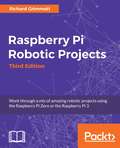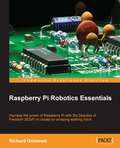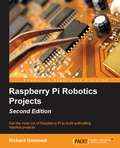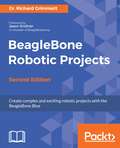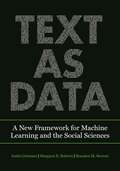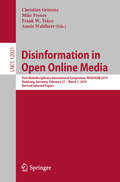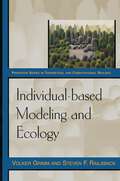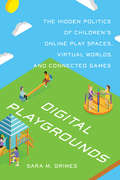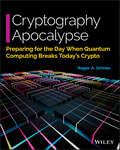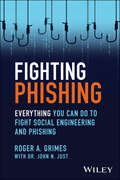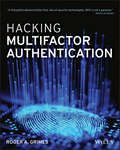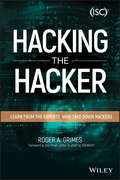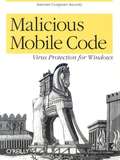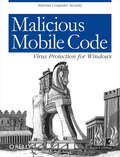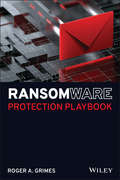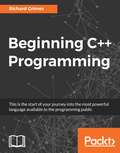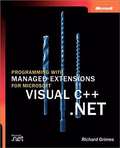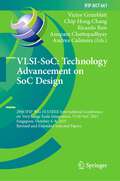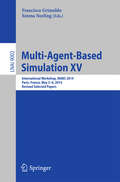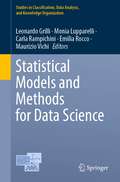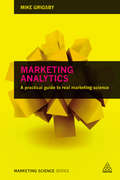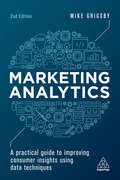- Table View
- List View
Raspberry Pi Robotic Projects - Third Edition
by Richard GrimmettWork through a mix of amazing robotic projects using the Raspberry Pi Zero or the Raspberry Pi 3 About This Book * Easy to follow instructions, yet the ones that help you build powerful robots, and exclusive coverage of mobile robots with the Pi Zero * Build robots that can run, swim and fly and the cutting-edge dimension of robotics that is possible with the Raspberry Pi Zero and Pi 3 * Interact with your projects wirelessly and make sci-fi possible, right in your home Who This Book Is For This book is for hobbyists and programmers who are excited about using the Raspberry Pi 3 and Raspberry Pi Zero. It is for those who are taking their first steps towards using these devices to control hardware and software and write simple programs that enable amazing projects. No programming experience is required, Just a little computer and mechanical aptitude and the desire to build some interesting projects. What You Will Learn * Control a variety of different DC motors * Add a USB webcam to see what your robot can see * Attach a projector to project information * Insert USB control hardware to control a complex robot with two legs * Include speech recognition so that your projects can receive commands * Add speech output to that the robot can communicate with the world around it * Include wireless communication so that you can see what the robot is seeing and control the robot from a distance In Detail This book will allow you to take full advantage of Raspberry Pi Zero and Raspberry Pi 3 by building both simple and complex robotic projects. The book takes a mission-critical approach to show you how to build amazing robots and helps you decide which board to use for which type of robot. The book puts a special emphasis on designing mobile (or movable) robots using the Raspberry Pi Zero. The projects will show inexpensive, yet powerful, ways to take full advantage. It will teach you how to program Raspberry Pi, control the movement of your robot, and add features to your robots. Style and approach This fun and practical tutorial contain step-by-step instructions to get you hands-on building inexpensive projects. It contains mission-critical chapters and everything you need to know to get started.
Raspberry Pi Robotics Essentials
by Richard GrimmettIf you are a programmer with an interest in building advanced robotics projects using inexpensive hardware and open source software, then this book is for you. Some experience with computer programming and implementing simple mechanical systems is required.
Raspberry Pi Robotics Projects - Second Edition
by Richard GrimmettThis book is for enthusiasts who want to use the Raspberry Pi to build complex robotics projects. With the aid of the step-by-step instructions in this book, you can construct complex robotics projects that can move, talk, listen, see, swim, or fly. No previous Raspberry Pi robotics experience is assumed, but even experts will find unexpected and interesting information in this invaluable guide.
BeagleBone Robotic Projects - Second Edition
by Dr Richard GrimmettExciting new capabilities to enable even easier DIY robotics with BeagleBone Blue About This Book • Build powerful robots with the all new BeagleBone Blue • Communicate with your robot and teach it to detect and respond to its environment • Control walking, rolling, swimming, and flying robots with your iOS and Android mobile devices Who This Book Is For This book is for anyone who is curious about using new, low-cost hardware to create robotic projects and have previously been the domain of research labs, major universities, or defence departments. Some programming experience would be useful, but if you know how to use a personal computer, you can use this book to construct far more complex systems than you would have thought possible. What You Will Learn • Power on and configure the BeagleBone Blue • Get to know Simple programming techniques to enable the unique hardware capabilities of the BeagleBone Blue. • Connect standard hardware to enable your projects to see, speak, hear, and move • Build advanced capabilities into your projects, such as GPS and sonar sensors • Build complex projects that can fly, or go under or on the water In Detail BeagleBone Blue is effectively a small, light, cheap computer in a similar vein to Raspberry Pi and Arduino. It has all of the extensibility of today's desktop machines, but without the bulk, expense, or noise. This project guide provides step-by-step instructions that enable anyone to use this new, low-cost platform in some fascinating robotics projects. By the time you are finished, your projects will be able to see, speak, listen, detect their surroundings, and move in a variety of amazing ways. The book begins with unpacking and powering up the components. This includes guidance on what to purchase and how to connect it all successfully, and a primer on programming the BeagleBone Blue. You will add additional software functionality available from the open source community, including making the system see using a webcam, hear using a microphone, and speak using a speaker. You will then learn to use the new hardware capability of the BeagleBone Blue to make your robots move, as well as discover how to add sonar sensors to avoid or find objects. Later, you will learn to remotely control your robot through iOS and Android devices. At the end of this book, you will see how to integrate all of these functionalities to work together, before developing the most impressive robotics projects: Drone and Submarine. Style and approach Develop practical example projects with detailed explanations, combine the projects in a vast number of ways to create different robot designs, or work through them in sequence to discover the full capability of the BeagleBone Blue.
Text as Data: A New Framework for Machine Learning and the Social Sciences
by Justin Grimmer Margaret E. Roberts Brandon M. StewartA guide for using computational text analysis to learn about the social world From social media posts and text messages to digital government documents and archives, researchers are bombarded with a deluge of text reflecting the social world. This textual data gives unprecedented insights into fundamental questions in the social sciences, humanities, and industry. Meanwhile new machine learning tools are rapidly transforming the way science and business are conducted. Text as Data shows how to combine new sources of data, machine learning tools, and social science research design to develop and evaluate new insights.Text as Data is organized around the core tasks in research projects using text—representation, discovery, measurement, prediction, and causal inference. The authors offer a sequential, iterative, and inductive approach to research design. Each research task is presented complete with real-world applications, example methods, and a distinct style of task-focused research.Bridging many divides—computer science and social science, the qualitative and the quantitative, and industry and academia—Text as Data is an ideal resource for anyone wanting to analyze large collections of text in an era when data is abundant and computation is cheap, but the enduring challenges of social science remain.Overview of how to use text as dataResearch design for a world of data delugeExamples from across the social sciences and industry
Disinformation in Open Online Media: First Multidisciplinary International Symposium, MISDOOM 2019, Hamburg, Germany, February 27 – March 1, 2019, Revised Selected Papers (Lecture Notes in Computer Science #12021)
by Christian Grimme Mike Preuss Frank W. Takes Annie WaldherrThis book constitutes the refereed proceedings of the First Multidisciplinary International Symposium, MISDOOM 2019, held in Hamburg, Germany, in February/March 2019. The 14 revised full papers were carefully reviewed and selected from 21 submissions. The papers are organized in topical sections named: human computer interaction and disinformation, automation and disinformation, media and disinformation.
Einführung in die Optimierung: Konzepte, Methoden und Anwendungen
by Christian Grimme Jakob BossekDieses Lehrbuch vermittelt einen breiten und grundlegenden Einblick in die Methoden der mathematischen Optimierung. Im Fokus stehen Algorithmen, verschiedene Optimierungsprobleme und ihre Komplexität sowie nützliche Lösungsmethoden. Dabei haben die Autoren, Informatiker und Optimierungsexperten der Westfälischen Wilhelms-Universität Münster, die Konzepte ausführlich und leicht verständlich dargestellt und außerdem viel Wert auf die Anwendung der Problemstellungen und Lösungsverfahren auf Beispielfälle gelegt. Denn ob Bauteile passend gemacht, Personaleinsatz effizient geplant oder Transportnetzwerke effektiv gestaltet werden sollen – immer geht es um die Verbesserung von Systemen und die strukturierte Durchführung dieser Optimierung. Das Fachgebiet der mathematischen Optimierung wird daher auch häufig als Operations Research oder Unternehmensforschung bezeichnet.Das Buch beginnt mit einer Einführung in die Grundbegriffe der Optimierung und die Graphentheorie und erläutert zunächst lineare Problemformulierungen sowie den Simplex-Algorithmus als zentrales Lösungsverfahren. Anschließend werden nichtlineare Problemstellungen und zumeist heuristische Verfahren beschrieben. Hier liegt der Schwerpunkt auf Evolutionären Algorithmen, einer Klasse von randomisierten Optimierungsverfahren, die bei der Lösung komplizierter ingenieurtechnischer Probleme immer mehr an Bedeutung gewinnen.Am Schluss des Buchs betrachten die Autoren das Thema aus der Perspektive der Entscheidungs- und Spieltheorie. Denn die Optimierung, wie sie in den vorangehenden Kapiteln betrachtet wird, ist genau genommen ein Spezialfall der Entscheidungstheorie. Der Band enthält zahlreiche Übungsaufgaben mit Lösungen, die die Autoren in ihren Vorlesungen erprobt haben. Alle praktischen Problemstellungen werden durch Lösungsimplementierungen in der Programmiersprache Python (ab Version 3) und, wo möglich, mit realen Datensätzen ergänzt. Zahlreiche praktische Beispiele und Anwendungsfälle, auch aus der aktuellen Forschung, stehen als vertiefendes Begleitmaterial online zur Verfügung.
Individual-based Modeling and Ecology (Princeton Series in Theoretical and Computational Biology #2)
by Volker Grimm Steven F. RailsbackIndividual-based models are an exciting and widely used new tool for ecology. These computational models allow scientists to explore the mechanisms through which population and ecosystem ecology arises from how individuals interact with each other and their environment. This book provides the first in-depth treatment of individual-based modeling and its use to develop theoretical understanding of how ecological systems work, an approach the authors call "individual-based ecology.? Grimm and Railsback start with a general primer on modeling: how to design models that are as simple as possible while still allowing specific problems to be solved, and how to move efficiently through a cycle of pattern-oriented model design, implementation, and analysis. Next, they address the problems of theory and conceptual framework for individual-based ecology: What is "theory"? That is, how do we develop reusable models of how system dynamics arise from characteristics of individuals? What conceptual framework do we use when the classical differential equation framework no longer applies? An extensive review illustrates the ecological problems that have been addressed with individual-based models. The authors then identify how the mechanics of building and using individual-based models differ from those of traditional science, and provide guidance on formulating, programming, and analyzing models. This book will be helpful to ecologists interested in modeling, and to other scientists interested in agent-based modeling.
The Unofficial Animal Crossing Cookbook
by Tom GrimmA Simon & Schuster eBook. Simon & Schuster has a great book for every reader.
Digital Playgrounds: The Hidden Politics of Children’s Online Play Spaces, Virtual Worlds, and Connected Games
by Sara GrimesDigital Playgrounds explores the key developments, trends, debates, and controversies that have shaped children’s commercial digital play spaces over the past two decades. It argues that children’s online playgrounds, virtual worlds, and connected games are much more than mere sources of fun and diversion – they serve as the sites of complex negotiations of power between children, parents, developers, politicians, and other actors with a stake in determining what, how, and where children’s play unfolds. Through an innovative, transdisciplinary framework combining science and technology studies, critical communication studies, and children’s cultural studies, Digital Playgrounds focuses on the contents and contexts of actual technological artefacts as a necessary entry point for understanding the meanings and politics of children’s digital play. The discussion draws on several research studies on a wide range of digital playgrounds designed and marketed to children aged six to twelve years, revealing how various problematic tendencies prevent most digital play spaces from effectively supporting children’s culture, rights, and – ironically – play. Digital Playgrounds lays the groundwork for a critical reconsideration of how existing approaches might be used in the development of new regulation, as well as best practices for the industries involved in making children’s digital play spaces. In so doing, it argues that children’s online play spaces be reimagined as a crucial new form of public sphere in which children’s rights and digital citizenship must be prioritized.
Cryptography Apocalypse: Preparing for the Day When Quantum Computing Breaks Today's Crypto
by Roger A. GrimesWill your organization be protected the day a quantum computer breaks encryption on the internet? Computer encryption is vital for protecting users, data, and infrastructure in the digital age. Using traditional computing, even common desktop encryption could take decades for specialized ‘crackers’ to break and government and infrastructure-grade encryption would take billions of times longer. In light of these facts, it may seem that today’s computer cryptography is a rock-solid way to safeguard everything from online passwords to the backbone of the entire internet. Unfortunately, many current cryptographic methods will soon be obsolete. In 2016, the National Institute of Standards and Technology (NIST) predicted that quantum computers will soon be able to break the most popular forms of public key cryptography. The encryption technologies we rely on every day—HTTPS, TLS, WiFi protection, VPNs, cryptocurrencies, PKI, digital certificates, smartcards, and most two-factor authentication—will be virtually useless. . . unless you prepare. Cryptography Apocalypse is a crucial resource for every IT and InfoSec professional for preparing for the coming quantum-computing revolution. Post-quantum crypto algorithms are already a reality, but implementation will take significant time and computing power. This practical guide helps IT leaders and implementers make the appropriate decisions today to meet the challenges of tomorrow. This important book: Gives a simple quantum mechanics primer Explains how quantum computing will break current cryptography Offers practical advice for preparing for a post-quantum world Presents the latest information on new cryptographic methods Describes the appropriate steps leaders must take to implement existing solutions to guard against quantum-computer security threats Cryptography Apocalypse: Preparing for the Day When Quantum Computing Breaks Today's Crypto is a must-have guide for anyone in the InfoSec world who needs to know if their security is ready for the day crypto break and how to fix it.
Fighting Phishing: Everything You Can Do to Fight Social Engineering and Phishing
by Roger A. GrimesKeep valuable data safe from even the most sophisticated social engineering and phishing attacks Fighting Phishing: Everything You Can Do To Fight Social Engineering and Phishing serves as the ideal defense against phishing for any reader, from large organizations to individuals. Unlike most anti-phishing books, which focus only on one or two strategies, this book discusses all the policies, education, and technical strategies that are essential to a complete phishing defense. This book gives clear instructions for deploying a great defense-in-depth strategy to defeat hackers and malware. Written by the lead data-driven defense evangelist at the world's number one anti-phishing company, KnowBe4, Inc., this guide shows you how to create an enduring, integrated cybersecurity culture. Learn what social engineering and phishing are, why they are so dangerous to your cybersecurity, and how to defend against them Educate yourself and other users on how to identify and avoid phishing scams, to stop attacks before they begin Discover the latest tools and strategies for locking down data when phishing has taken place, and stop breaches from spreading Develop technology and security policies that protect your organization against the most common types of social engineering and phishing Anyone looking to defend themselves or their organization from phishing will appreciate the uncommonly comprehensive approach in Fighting Phishing.
Hacking Multifactor Authentication
by Roger A. GrimesProtect your organization from scandalously easy-to-hack MFA security “solutions” Multi-Factor Authentication (MFA) is spreading like wildfire across digital environments. However, hundreds of millions of dollars have been stolen from MFA-protected online accounts. How? Most people who use multifactor authentication (MFA) have been told that it is far less hackable than other types of authentication, or even that it is unhackable. You might be shocked to learn that all MFA solutions are actually easy to hack. That’s right: there is no perfectly safe MFA solution. In fact, most can be hacked at least five different ways. Hacking Multifactor Authentication will show you how MFA works behind the scenes and how poorly linked multi-step authentication steps allows MFA to be hacked and compromised. This book covers over two dozen ways that various MFA solutions can be hacked, including the methods (and defenses) common to all MFA solutions. You’ll learn about the various types of MFA solutions, their strengthens and weaknesses, and how to pick the best, most defensible MFA solution for your (or your customers') needs. Finally, this book reveals a simple method for quickly evaluating your existing MFA solutions. If using or developing a secure MFA solution is important to you, you need this book. Learn how different types of multifactor authentication work behind the scenes See how easy it is to hack MFA security solutions—no matter how secure they seem Identify the strengths and weaknesses in your (or your customers’) existing MFA security and how to mitigate Author Roger Grimes is an internationally known security expert whose work on hacking MFA has generated significant buzz in the security world. Read this book to learn what decisions and preparations your organization needs to take to prevent losses from MFA hacking.
Hacking the Hacker: Learn From the Experts Who Take Down Hackers
by Roger A. GrimesMeet the world's top ethical hackers and explore the tools of the trade Hacking the Hacker takes you inside the world of cybersecurity to show you what goes on behind the scenes, and introduces you to the men and women on the front lines of this technological arms race. Twenty-six of the world's top white hat hackers, security researchers, writers, and leaders, describe what they do and why, with each profile preceded by a no-experience-necessary explanation of the relevant technology. Dorothy Denning discusses advanced persistent threats, Martin Hellman describes how he helped invent public key encryption, Bill Cheswick talks about firewalls, Dr. Charlie Miller talks about hacking cars, and other cybersecurity experts from around the world detail the threats, their defenses, and the tools and techniques they use to thwart the most advanced criminals history has ever seen. Light on jargon and heavy on intrigue, this book is designed to be an introduction to the field; final chapters include a guide for parents of young hackers, as well as the Code of Ethical Hacking to help you start your own journey to the top. Cybersecurity is becoming increasingly critical at all levels, from retail businesses all the way up to national security. This book drives to the heart of the field, introducing the people and practices that help keep our world secure. Go deep into the world of white hat hacking to grasp just how critical cybersecurity is Read the stories of some of the world's most renowned computer security experts Learn how hackers do what they do—no technical expertise necessary Delve into social engineering, cryptography, penetration testing, network attacks, and more As a field, cybersecurity is large and multi-faceted—yet not historically diverse. With a massive demand for qualified professional that is only going to grow, opportunities are endless. Hacking the Hacker shows you why you should give the field a closer look.
Malicious Mobile Code: Virus Protection for Windows
by Roger A. Grimes"Malicious mobile code" is a new term to describe all sorts of destructive programs: viruses, worms, trojans, and rogue Internet content. Malicious mobile code is more prevalent today than ever before, and both home users and system administrators need to be on the alert to protect their network or company against attacks. Malicious Mobile Code reveals what such code can and can't do and how to recognize, remove, and prevent it. Readers learn effective strategies, tips, and tricks for securing any system.
Malicious Mobile Code: Virus Protection for Windows
by Roger A. GrimesMalicious mobile code is a new term to describe all sorts of destructive programs: viruses, worms, Trojans, and rogue Internet content. Until fairly recently, experts worried mostly about computer viruses that spread only through executable files, not data files, and certainly not through email exchange. The Melissa virus and the Love Bug proved the experts wrong, attacking Windows computers when recipients did nothing more than open an email. Today, writing programs is easier than ever, and so is writing malicious code. The idea that someone could write malicious code and spread it to 60 million computers in a matter of hours is no longer a fantasy.The good news is that there are effective ways to thwart Windows malicious code attacks, and author Roger Grimes maps them out inMalicious Mobile Code: Virus Protection for Windows. His opening chapter on the history of malicious code and the multi-million dollar anti-virus industry sets the stage for a comprehensive rundown on today's viruses and the nuts and bolts of protecting a system from them. He ranges through the best ways to configure Windows for maximum protection, what a DOS virus can and can't do, what today's biggest threats are, and other important and frequently surprising information. For example, how many people know that joining a chat discussion can turn one's entire computer system into an open book?Malicious Mobile Code delivers the strategies, tips, and tricks to secure a system against attack. It covers:The current state of the malicious code writing and cracker communityHow malicious code works, what types there are, and what it can and cannot doCommon anti-virus defenses, including anti-virus softwareHow malicious code affects the various Windows operating systems, and how to recognize, remove, and prevent itMacro viruses affecting MS Word, MS Excel, and VBScriptJava applets and ActiveX controlsEnterprise-wide malicious code protectionHoaxesThe future of malicious mobile code and how to combat such codeThese days, when it comes to protecting both home computers and company networks against malicious code, the stakes are higher than ever.Malicious Mobile Code is the essential guide for securing a system from catastrophic loss.
Malicious Mobile Code
by Roger A. GrimesMalicious mobile code is a new term to describe all sorts of destructive programs: viruses, worms, Trojans, and rogue Internet content. Until fairly recently, experts worried mostly about computer viruses that spread only through executable files, not data files, and certainly not through email exchange. The Melissa virus and the Love Bug proved the experts wrong, attacking Windows computers when recipients did nothing more than open an email. Today, writing programs is easier than ever, and so is writing malicious code. The idea that someone could write malicious code and spread it to 60 million computers in a matter of hours is no longer a fantasy. The good news is that there are effective ways to thwart Windows malicious code attacks, and author Roger Grimes maps them out in Malicious Mobile Code: Virus Protection for Windows. His opening chapter on the history of malicious code and the multi-million dollar anti-virus industry sets the stage for a comprehensive rundown on today's viruses and the nuts and bolts of protecting a system from them. He ranges through the best ways to configure Windows for maximum protection, what a DOS virus can and can't do, what today's biggest threats are, and other important and frequently surprising information. For example, how many people know that joining a chat discussion can turn one's entire computer system into an open book? Malicious Mobile Code delivers the strategies, tips, and tricks to secure a system against attack. It covers: The current state of the malicious code writing and cracker community How malicious code works, what types there are, and what it can and cannot do Common anti-virus defenses, including anti-virus software How malicious code affects the various Windows operating systems, and how to recognize, remove, and prevent it Macro viruses affecting MS Word, MS Excel, and VBScript Java applets and ActiveX controls Enterprise-wide malicious code protection Hoaxes The future of malicious mobile code and how to combat such code These days, when it comes to protecting both home computers and company networks against malicious code, the stakes are higher than ever. Malicious Mobile Code is the essential guide for securing a system from catastrophic loss.
Ransomware Protection Playbook
by Roger A. GrimesAvoid becoming the next ransomware victim by taking practical steps today Colonial Pipeline. CWT Global. Brenntag. Travelex. The list of ransomware victims is long, distinguished, and sophisticated. And it’s growing longer every day. In Ransomware Protection Playbook, computer security veteran and expert penetration tester Roger A. Grimes delivers an actionable blueprint for organizations seeking a robust defense against one of the most insidious and destructive IT threats currently in the wild. You’ll learn about concrete steps you can take now to protect yourself or your organization from ransomware attacks. In addition to walking you through the necessary technical preventative measures, this critical book will show you how to: Quickly detect an attack, limit the damage, and decide whether to pay the ransom Implement a pre-set game plan in the event of a game-changing security breach to help limit the reputational and financial damage Lay down a secure foundation of cybersecurity insurance and legal protection to mitigate the disruption to your life and business A must-read for cyber and information security professionals, privacy leaders, risk managers, and CTOs, Ransomware Protection Playbook is an irreplaceable and timely resource for anyone concerned about the security of their, or their organization’s, data.
Beginning C++ Programming
by Richard GrimesModern C++ at your fingertips! About This Book • This book gets you started with the exciting world of C++ programming • It will enable you to write C++ code that uses the standard library, has a level of object orientation, and uses memory in a safe and effective way • It forms the basis of programming and covers concepts such as data structures and the core programming language Who This Book Is For A computer, an internet connection, and the desire to learn how to code in C++ is all you need to get started with this book. What You Will Learn • Get familiar with the structure of C++ projects • Identify the main structures in the language: functions and classes • Feel confident about being able to identify the execution flow through the code • Be aware of the facilities of the standard library • Gain insights into the basic concepts of object orientation • Know how to debug your programs • Get acquainted with the standard C++ library In Detail C++ has come a long way and is now adopted in several contexts. Its key strengths are its software infrastructure and resource-constrained applications, including desktop applications, servers, and performance-critical applications, not to forget its importance in game programming. Despite its strengths in these areas, beginners usually tend to shy away from learning the language because of its steep learning curve. The main mission of this book is to make you familiar and comfortable with C++. You will finish the book not only being able to write your own code, but more importantly, you will be able to read other projects. It is only by being able to read others' code that you will progress from a beginner to an advanced programmer. This book is the first step in that progression. The first task is to familiarize you with the structure of C++ projects so you will know how to start reading a project. Next, you will be able to identify the main structures in the language, functions, and classes, and feel confident being able to identify the execution flow through the code. You will then become aware of the facilities of the standard library and be able to determine whether you need to write a routine yourself, or use an existing routine in the standard library. Throughout the book, there is a big emphasis on memory and pointers. You will understand memory usage, allocation, and access, and be able to write code that does not leak memory. Finally, you will learn about C++ classes and get an introduction to object orientation and polymorphism. Style and approach This straightforward tutorial will help you build strong skills in C++ programming, be it for enterprise software or for low-latency applications such as games or embedded programming. Filled with examples, this book will take you gradually up the steep learning curve of C++.
Programming with Managed Extensions for Microsoft® Visual C++® .NET
by Richard Grimes<div xmlns="http://www.w3.org/1999/xhtml"><p>This book thoroughly covers the Visual C++ managed extensions and how to write Microsoft .NET libraries and applications, plus features that are new to Visual C++.</p></div>
VLSI-SoC: 29th IFIP WG 10.5/IEEE International Conference on Very Large Scale Integration, VLSI-SoC 2021, Singapore, October 4–8, 2021, Revised and Extended Selected Papers (IFIP Advances in Information and Communication Technology #661)
by Victor Grimblatt Chip Hong Chang Ricardo Reis Anupam Chattopadhyay Andrea CalimeraThis book contains extended and revised versions of the best papers presented at the 29th IFIP WG 10.5/IEEE International Conference on Very Large Scale Integration, VLSI-SoC 2021, held in Singapore, in October 2021*.The 12 full papers included in this volume were carefully reviewed and selected from the 44 papers (out of 75 submissions) presented at the conference. The papers discuss the latest academic and industrial results and developments as well as future trends in the field of System-on-Chip (SoC) design, considering the challenges of nano-scale, state-of-the-art and emerging manufacturing technologies. In particular they address cutting-edge research fields like low-power design of RF, analog and mixed-signal circuits, EDA tools for the synthesis and verification of heterogenous SoCs, accelerators for cryptography and deep learning and on-chip Interconnection system, reliability and testing, and integration of 3D-ICs.*The conference was held virtually.
Multi-Agent-Based Simulation XV
by Francisco Grimaldo Emma NorlingThis book constitutes the thoroughly refereed post-conference proceedings of the 15th International Workshop on Multi-Agent-Based Simulation, MABS 2014, held in Paris, France, in May 2014. The workshop was held in conjunction with the 13th International Conference on Autonomous Agents and Multiagent Systems, AAMAS 2014. The 17 revised full papers included in this volume were carefully selected from numerous submissions. The papers are organized in topical sections on simulation methodologies, simulation of social behaviour, data and multi-agent-based simulation and applications.
Statistical Models and Methods for Data Science (Studies in Classification, Data Analysis, and Knowledge Organization)
by Leonardo Grilli Monia Lupparelli Carla Rampichini Emilia Rocco Maurizio VichiThis book focuses on methods and models in classification and data analysis and presents real-world applications at the interface with data science. Numerous topics are covered, ranging from statistical inference and modelling to clustering and factorial methods, and from directional data analysis to time series analysis and small area estimation. The applications deal with new developments in a variety of fields, including medicine, finance, engineering, marketing, and cyber risk.The contents comprise selected and peer-reviewed contributions presented at the 13th Scientific Meeting of the Classification and Data Analysis Group of the Italian Statistical Society, CLADAG 2021, held (online) in Florence, Italy, on September 9–11, 2021. CLADAG promotes advanced methodological research in multivariate statistics with a special focus on data analysis and classification, and supports the exchange and dissemination of ideas, methodological concepts, numerical methods, algorithms, and computational and applied results at the interface between classification and data science.
Marketing Analytics
by Mike GrigsbyMarketing Analytics arms business analysts and marketers with the marketing science understanding and techniques they need to solve real-world marketing problems, from pulling a targeted list and segmenting data to testing campaign effectiveness and forecasting demand. Assuming no prior knowledge, this book outlines everything practitioners need to 'do' marketing science and demonstrate value to their organization. It introduces concepts relating to statistics, marketing strategy and consumer behaviour and then works through a series of marketing problems in a straightforward, jargon-free way. It demonstrates solutions for various data modelling scenarios and includes full workings and critical analyses to reinforce the key concepts. By starting with the marketing problem and then sharing a series of data modelling options on how to solve it, Marketing Analytics both makes marketing science accessible for beginners and aids the more seasoned practitioner in getting to grips with the trickier technical aspects of data analytics to refine their marketing skills and toolkit and compete more effectively in the marketplace. Online supporting resources for this book include a bank of test questions as well as data sets relating to a number of chapters. About the series: The Marketing Science series makes difficult topics accessible to marketing students and practitioners by grounding them in business reality. Each book is written by an expert in the field and includes case studies and illustrations enabling marketers to gain confidence in applying the tools and techniques and in commissioning external research.
Marketing Analytics: A Practical Guide to Improving Consumer Insights Using Data Techniques (Marketing Science Ser.)
by Mike GrigsbyWho is most likely to buy and what is the best way to target them? How can businesses improve strategy without identifying the key influencing factors? The second edition of Marketing Analytics enables marketers and business analysts to leverage predictive techniques to measure and improve performance. By exploring real-world marketing challenges, it provides clear, jargon-free explanations on how to apply different analytical models for each purpose. From targeted list creation and data segmentation, to testing campaign effectiveness, pricing structures and forecasting demand, this book offers a welcome handbook on how statistics, consumer analytics and modelling can be put to optimal use. The fully revised second edition of Marketing Analytics includes three new chapters on big data analytics, insights and panel regression, including how to collect, separate and analyze big data. All of the advanced tools and techniques for predictive analytics have been updated, translating models such as tobit analysis for customer lifetime value into everyday use. Whether an experienced practitioner or having no prior knowledge, methodologies are simplified to ensure the more complex aspects of data and analytics are fully accessible for any level of application. Complete with downloadable data sets and test bank resources, this book supplies a concrete foundation to optimize marketing analytics for day-to-day business advantage.
